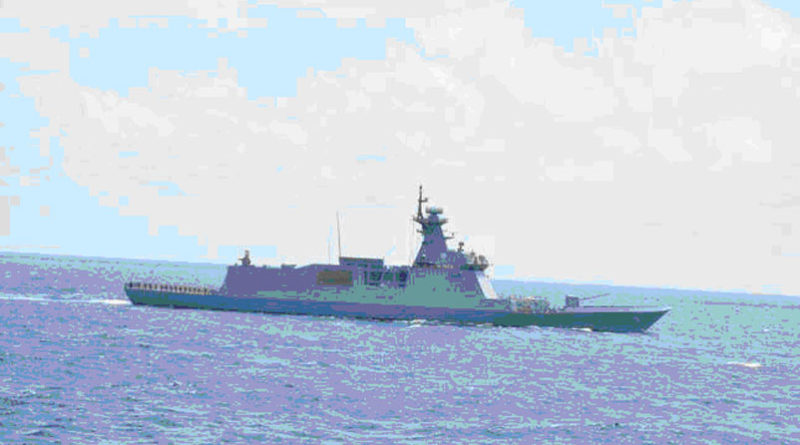INS Kiltan Has Become The Strategic Flag-Bearer Of India’s Act East Policy
01 August 2021
The warship has been a significant pillar in India’s policies at a time when maritime sub-regions in the Pacific have been subject to China’s assertive actions.
On 3 July, the Indian Navy’s INS Kiltan took a quick stop in the Philippines as part of its deployment in the Indo-Pacific Region. This came after a successful military drill conducted between the Indian warship and a South Korean naval vessel in the East China Sea. Since it joined the Indian Navy in 2017, the INS Kiltan has been a significant pillar in India’s Act East Policy at a time when the maritime sub-regions in the Pacific have been subject to China’s assertive actions.
On 20 June, Japan said that two Chinese coast guard ships had entered the Japanese-administered Senkaku Islands in the East China Sea. This happened several times in April and May too, as reported by WION, leading to reinvigorated tensions between the two East Asian countries. Moreover, China’s strategic designs to project power and increase influence in the South China Sea are also concerning given the call for readiness for a “people’s war at sea” by China’s defence minister, General Chang Wanquan.
INS Kiltan And India’s Act East Policy
The indigenously built INS Kiltan is an anti-submarine warfare stealth corvette. The warship is the third of four Kamorta-class corvettes being built under Project 28. According to a Ministry of Defence press release, the INS Kiltan “portrays the growing capability of the Indian Navy and the significance of Make in India in the defence sector”.
The INS Kiltan is India’s first major naval ship to contain a superstructure of carbon fibre composite material. This allows for more enhanced stealth features and lower costs for overall maintenance. The warship also utilises a largely indigenous collection of advanced weapons and sensors, such as heavyweight torpedoes, anti-submarine warfare (ASW) rockets, missile decoy rockets, an advanced electronic support measure (ESM) system, and a highly advanced bow-mounted sonar and air surveillance radar, among many others.
The INS Kiltan is part of the Indian Navy’s Eastern Naval Command, which is the flag bearer of India’s Act East policy. A major component of India’s strategic engagements in East Asia centres on naval cooperation and maritime security. With critical shifts in the regional geopolitical landscape in East Asia, the INS Kiltan has proven to be a formidable element in India’s strategic outreach in the seas.
Mapping Operations In East Asia
The year 2019 was significant for the INS Kiltan in the context of its activities in East Asia. As Japan battled the devastation and turbulence brought by Typhoon Hagibis, the Indian Navy deployed the INS Kiltan and the INS Sahyadri to provide assistance.
On 23 October 2019, the INS Kiltan and INS Sahyadri made a port call in Manila. While operating in the South China Sea for weeks, the INS Kiltan made other port calls in key Southeast Asian countries such as Malaysia, Thailand, and Cambodia as well. These engagements represent India’s desire to deepen its strategic partnership throughout the region.
From 26 September to 4 October 2019, the two ships also participated in the Malabar 2019 trilateral maritime exercise in the Pacific Ocean along with United States Navy and the Japan Maritime Self-Defense Force. This aimed to further strengthen naval cooperation between the three countries and to enhance cooperation and interoperability, based on the shared desire to secure and maintain rules-based order in the region. A month later, the Indian warship took on a three-day visit to Indonesia, which led to its participation in a passing exercise (PASSEX) with the Indonesian Navy in critical maritime spaces in the Pacific.
New Impetus For The Warship
The year 2020, however, provided a new impetus to the operations of the INS Kiltan. This was due to the Covid-19 pandemic coupled with a series of natural calamities that took place in Southeast Asia. Accordingly, Mission Sagar-III was enshrined as a part of India’s humanitarian assistance and disaster relief (HADR) initiative towards its eastern neighbours.
This mission also significantly banks on Prime Minister Narendra Modi’s vision of Security and Growth for All in the Region (SAGAR). It also highlights India’s position as a reliable ally and net security provider throughout the greater Indo-Pacific. Furthermore, it highlights the importance of Southeast Asian countries in India’s strategic and foreign policy calculus.
On 24 December 2020, the INS Kiltan reached Nha Rhong port in Vietnam, bringing approximately 15 tonnes of disaster relief items for the flood-stricken people. The INS Kiltan then arrived at the Sihanoukville Port in Cambodia with another 15 tonnes of disaster relief material for those affected by the floods.
This year, the INS Kiltan was deployed in the Far East, and conducted a military drill with South Korea’s Daegu-class frigate ROKS Gyeongnam in the East China Sea on 28 June. The naval cooperation aimed to strengthen the military and defence partnership between the two countries in the maritime domain. Upon its conclusion, the warship made a quick stop in Manila on 3 July, signalling the steadfast desire of India to maintain close relations with the region. The stop in Manila set the tone for more potential strategic engagements in the future, including a possible and long-overdue bilateral naval exercise.
The successful ongoing operations of the INS Kiltan in East Asia represent the significance of India’s Make in India initiative and its Act East Policy. This has positive implications for the role of the Indian Navy as a security provider throughout the greater Indo-Pacific, regardless of China’s moves.
Courtesy: The Print

